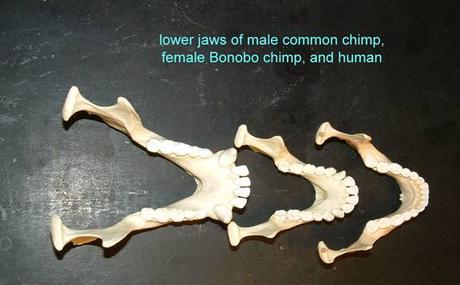Over the course of human evolution, our diet changed dramatically. As a result of this, our mouth did too. So we now have the most distinctive jaws amongst the apes. But all of that evolution is surely in the distant past.
After all, we now use technology, rather than our teeth, to prepare food. Who needs to evolve a super cool mouth when we have a fire and tools to do the work for us?
This was a fairly common view amongst scientists but it turns out they were wrong. New research reveals our mouth never stopped evolving, adapting faster (and for longer) than in any other primate 1.
Our evolving mouth
In the past 4 million years, the human family - technically labelled "hominins" - has changed a lot. We started this period as small, ape-like creatures that spent most of their time in trees. By the present, we'd become, well, present-day humans. The clue is in the name.
Our mouth is no exception to this. For instance, at the start of this period, we had pointy canines that stayed sharp by grinding on other teeth.
To track when and what happened, a group of European researchers (mostly based out of Italy) carried out a series of statistical tests, quantifying the variation seen in primate jaws. This allowed them to chart these jaws, seeing how much they really differed 1.
This confirmed that our jaw was - and still is - fairly distinctive 1. But it doesn't shed much light on the chronology of our evolution. Did it really stop in recent species?
So they built a primate family tree. For each species, they estimated how much their jaw had evolved relative to their ancestors. If evolution did slow down in the hominin mouth, only early species should show high rates of change 1.
Plot twist: They didn't.
Now, there's still a lot we don't know about human evolution. As such, the researchers had to make a fair few assumptions when building this family tree. So to make sure these results weren't just a fluke caused by their premises they re-ran this test 100 times, each with a slightly different set of assumptions 1.
The results remained consistent. The human mouth has been evolving the entire time 1.
What changed? And why?
Ok, so we know our mouth has changed a lot over the course of our evolution. But surely this change hasn't been consistent over the past 4 million years. After all, in later species, we started cooking and preparing our food. Might our evolution have changed gears in response to that?
Not really. When examining the evolutionary changes occurring in hominins, they found similar changes occurring in many species. For instance, our face was becoming flatter (thanks to a jaw that doesn't stick out as much) in both early and later species. Other changes seen across our lineage are smaller canines, bigger molars, a wider mouth, along with changes to obscure bits of anatomy I'm not even sure I fully understand 1.

The implication of all this is that evolution has been driving our mouth in a similar direction for the past 4 million years. This suggests whatever it's been adapting to has been impacting us for about this long, causing long-term evolution.
The researchers speculate that this might have been tool use. There are some indications even early species were also using tools to prepare food. Perhaps our mouth has just been adapting to them the whole time 1.
An alternative I quite like is that our mouth is actually becoming more generalised. Between our tools and our teeth, we can chew just about anything we want, from tubers to turkeys. This sort of flexibility may be what our teeth have been evolving towards. Even as early as Lucy, our ancestor's mouth allowed them to have a uniquely flexible diet, helping them to flourish in the face of changing conditions.
Of course, both of these explanations are just speculative. But at least now we know something changed, we can begin looking at the why.
References
- Raia, P., Boggioni, M., Carotenuto, F., Castiglione, S., Febbraro, M., Vincenzo, F., Melchionna, M., Mondanaro, A., Papini, A., Profico, A. and Serio, C., 2018. Unexpectedly rapid evolution of mandibular shape in hominins. Scientific reports, 8(1), p.7340.

